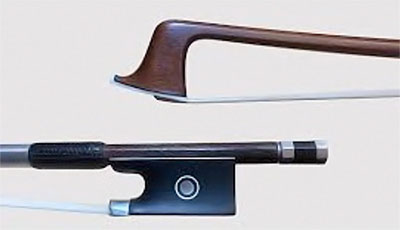The more you know the better your Bow
The bow you presently use could possibly be unsuitable for you. Its qualities may be anything apart from advantageous for you. Thus when purchasing a new bow, do not expect the bow to have the same features. If you have developed any habits to compromise the shortcomings of your present bow, it would be beneficial to obtain a bow that does not hinder bowing technique. Too much hair on a bow “exhausts the strength” of a bow, instead of giving it a greater strength that some players are seeking. Also, too much hair makes a bow awkward in movement and suppresses the sound by its limited vibrations. For each bow there is a correct amount of hair which is determined by the space in the tip and the frog, and not by a player’s wish.
 When purchasing a bow, only you the player can decide whether or not the bow is comfortable. Always test a bow personally on your own instrument. No-one can decide for you which bow is best. The bow, instrument and you should work in harmony and facilitate for example, a fluent staccato, an effortless spiccato and a full tone.
When purchasing a bow, only you the player can decide whether or not the bow is comfortable. Always test a bow personally on your own instrument. No-one can decide for you which bow is best. The bow, instrument and you should work in harmony and facilitate for example, a fluent staccato, an effortless spiccato and a full tone.
It is important to take into consideration the balance of a bow, while the weight is relatively unimportant. Some woods are light but strong, and others can be heavy but weak, and vice-versa. Thus weighing a bow is relatively meaningless. A bow should be easily flexible (but not too easily), and should be firm at the same time. There should also be enough strength in reserve in the bow to give you the feeling that you get a full-bodied sound. It is not correct to need to use the full capacity force of a bow to obtain a full capacity sound. To find a good tonal balance, it is advisable to match a bright and sparkling sounding instrument with a dull sounding bow, and a dull sounding instrument with a bright and sparkling sounding bow.
When playing in public it is wise to own more than one bow so that you are accustomed to the alternative bow in case one of them is in need of rehair or repair. It is advisable to give your bow a rest occasionally, after constant tension and use. You may find that a different bow is needed as humidity, pressure and temperature affect your instrument and playing. Neither a bow nor instrument should be unfamiliar to you.
Wood for instruments and bows is expensive and increasingly harder to get. It is easier to damage a good bow than a poor bow, and a bow is less easily repaired than an instrument. A bow may look simple and elegant in appearance, but bow making is an art and requires high skills. A good bow is valuable. The camber and each part plays a critical role. Any wear or fracture should therefore be restored immediately.

